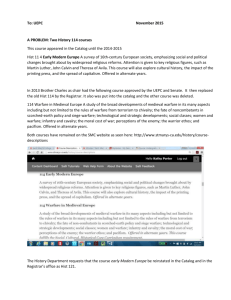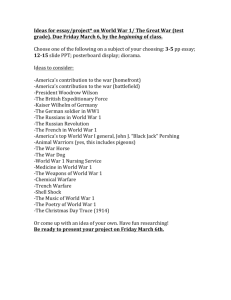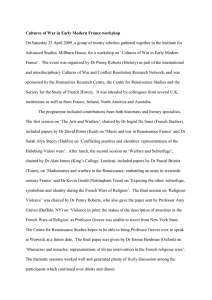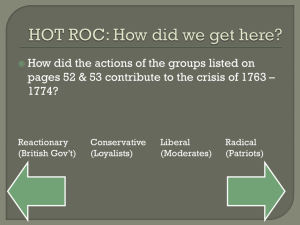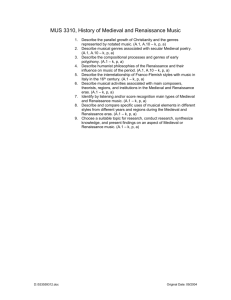The Art of War in the Renaissance
advertisement
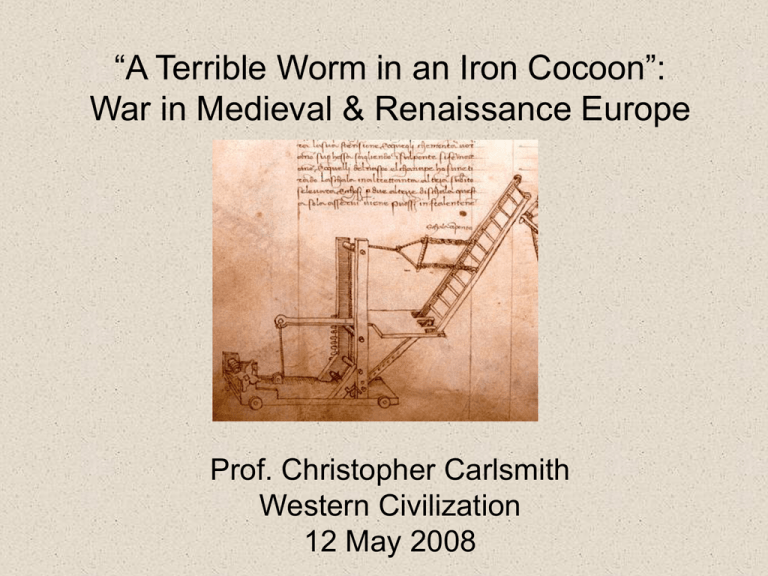
“A Terrible Worm in an Iron Cocoon”: War in Medieval & Renaissance Europe Prof. Christopher Carlsmith Western Civilization 12 May 2008 Comparing Past and Present • For each of the military conflicts listed, discuss in pairs: – Did offensive or defensive forces hold the advantage? – What new military technology (if any) changed the balance of power? • Iraq War / Gulf War (2003-present, 1991-92) • WW I (1914-18) / WWII (1941-1945) • Amer. Rev. (1776-83) • Medieval/Renaiss. wars (14th-16th c.) Agenda • Preface • Comparing warfare, past and present • Introduction • Areas of change • Offense vs. Defense • Medieval Warfare • Equipment: Castles, cavalry, crossbow, trebuchet • Strategy • Renaissance Warfare • • • • Revisiting the Classical World Gunpowder: The Big Bang Cannon, musket, mortar Fortifications Art of War: a “revolution”? • “Renaissance war” • Leonardo • Michelangelo • Machiavelli • Areas of change • Offense vs. Defense? • 14th c. = D. • 15th c. = O. • 16th c. = D. Leonardo’s study of catapults Leonardo’s sketch of tanks Medieval Warfare • Castles – Defense > residence – Ex: Castle Coucy (FR) Castle (Donjon) of Coucy Medieval Warfare • Cavalry – Dominates until 1370s – Equiv. to modern tank – “terrible worm in an iron cocoon” – Chivalry & nobility rules – Multiple attendants (how many “lances”?) – Ex: Knights Templar Medieval Warfare • Trebuchet – Classic siege engine • Catapult Medieval Warfare • Crossbow – Slow, awkward, but devastating force – Banned by RCC in 1139 – Imp’t till 14th c. • Longbow – Introduced in 100 Yrs. War by English – 12 arrows/min, 300 yd. range Medieval Warfare xenophongroup.com/montjoie/ ngp_arty.htm Medieval Warfare • Strategy – Joint use of forces (archers, cavalry, etc) – Limited by weather & distance – Divided leadership is common – Pillage is common, both during & after Medieval Warfare Who will win this battle, and why? Renaissance Warfare: When & Where & Who? Renaissance Warfare: Looking to the Classical World Roman soldiers battering a door, from Roberto Valturio (ca. 1550) Renaissance Warfare: Looking to the Classical World Guido delle Colonne, History, Siege, and Destruction of Troy (1513) Renaissance Warfare: Looking to the Classical World Tactics of Aelian, trans. John Bingham (1616) Renaissance Warfare: Gunpowder Gunpowder • Origins • From Asia • Carbon, saltpeter, sulphur • Criticism • 1467, 1497 • Praise • See next Praising Gunpowder F. Malthus, Treatise of Fireworks (1629) J. Babington, Pyrotechnia Mortar • = mechanized trebuchet Cannon Cannon Musket & Arquebus Musketeer Musket-Loading Infantry Pikeman Evolving Strategy Fortifications • Better artillery better fortifications • Medieval towers cut down, transformed into “bastions” and gun platforms • “The most significant architectural form during the Renaiss. was the angle bastion; it revolutionized patterns of warfare.” (John Hale) Angle Bastions Renaissance Fortifications in the New World Renaissance Warfare: ?!? Renaissance Warfare: Some Conclusions

